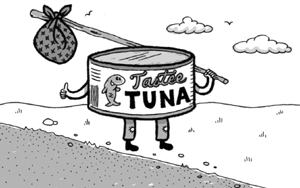|
|
|
|
The
Journey of a Tuna Fish Tin- A Look at Food Waste in Champaign-Urbana
by Zuzana Ocenasova |
|
|
|
 "Food
in this country - we waste it a lot and we eat it a lot.
We eat too much "Food
in this country - we waste it a lot and we eat it a lot.
We eat too much
of it. It is a kind of weird dichotomy," says Benita
Vonne Ortiz, recycling coordinator of the housing division
of the University of Illinois. Her small office is illuminated
by a few sun-beams and the glow of a computer screen.
Mrs. Ortiz isnít speaking about food waste in the
United States for the first time. She has long been a
passionate anti-waste fighter, working for "the time
that has not yet comeî.
America is a wealthy country, where 'wealth' means having
a full stomach as well as something left over. But wealth
brings surplus. The United States Department of Agriculture
estimates that 96 billion pounds of edible food are wasted
and dumped in landfills each year. According to the Environmental
Protection Agency, only five percent of wasted food is
diverted or recovered.
"Most Americans don't consider themselves as wasting
food. As far as food goes, they don't think their actions
really have a consequence. They don't even see it as an
issue", says Ortiz. " In this country people
really feel they are entitled to things. Everything belongs
to them because they paid for it. It takes a lot for me
to make decisions not to buy certain things, not to do
things in certain way, because the message is out there
all the time: you're entitled to take this and that because
it is cheaper and it is quicker".
In seeming contrast to her peaceful blue eyes and fragile
wrists, Ortiz has fought patiently against the beast of
waste. At the end of each semester since1986, she has
set up drop-off areas in the hall lobbies of the housing
facilities of UIUC as part of her "Don't Toss It,
Salvage It!" food and clothes waste program. "In
our halls we provide a board contract of meals. If you
go down to eat, you can drink and eat as much as you want.
If you'd go to their rooms of these students and open
the closet, you'd find hot chocolate, tea, tuna fish,
peanut butter and jelly ñ whatever. Their parents
are sending them the food, because they think they're
starving to death. So, at the end of the school year,
they say, 'I don't want to take all this stuff' and they
put it into my salvage drive", Ortiz says.
Since 1986, the amount of collected food and clothing
has risen from 6,500 pounds to 12,820 pounds in the spring
of 2001. Collected items are distributed to local charities
like Salvation Army and Eastern Illinois Food Bank. Twice
a year, the anxious parents of the privileged kids feed
the Champaign area's poor.
According to the Unites States Department of Commerce,
Bureau of the Census 1990, there have been 84,636 persons
below the poverty level (average minimum income for a
family according to number of members, as defined by the
Census Bureau) in Champaign-Urbana. The Bureau reports
that the poverty rate has been higher for Champaign County
(15.6%) than the Illinois poverty level (11.9%) and the
national level (13.1%).
"It is a way of thinking, poor thinking", says
Lillian VanVleet, a pale woman in a big red apron who
works for the Social services Center of Salvation Army
in Champaign. Her clients are Champaign-area citizens
in need. "That's the way they've chosen to live".
She exempts from her judgement two special groups: seniors
and single mothers.
"To be an unmarried mother is a stigma of being poor",
she says. Lillian serves 400 to 550 people a month from
her table at 125 E. University Ave in Champaign. "Most
of them are picky. Food must be perfect; otherwise they
don't take it. They've called and complained to the mayor
that I've given them bad foodî.
Salvation Army corps officer Violet Windham doesn't think
that people are really starving here. She believes that
there is fair network of agencies all over the country
which are prepared to provide food. "Usually when
people really are starving, it is because the adult household
member doesn't have what it takes up here (she points
to her head) to call these agencies. They cannot even
use the telephone, they cannot read, they don't have a
clue that there's all that stuff available."
Kathy Smith, the director of the Center of Woman in Transition
in Champaign, sees the problem in blaming those who are
poor. "It's too simplistic to say, it's your fault.
That's a fairy tale that is told in this country".
Eastern Illinois Food Bank in Urbana and Salvation Army
in Champaign are two area organizations that redistribute
surplus food to those in need. The tin of tuna from the
closet of the wealthy student salvaged by Mrs. Ortiz's
drive probably goes to the Eastern Illinois Food Bank
warehouse where it is sorted and redistributed to smaller
agencies. "We serve the great purpose, because these
small agencies cannot do it on their own. They cannot
get the food that is unmarketable, because they cannot
store it", says Cindi Parr, director of development
of the Eastern Illinois Food Bank.
Salvation Army Social Services Center in Champaign is
one of the places where an abandoned tin of tuna from
a student's closet can finally meet its consumer. Here
is where Champaignís poor go. A big glass wall
with the view of the street is the focus of most Salvation
Army visitors, while the pictures of saints on the shabby
blue walls don't seem to receive much attention. Sitting
somberly on the chairs, the visitors wait for their once-per-month
brown package of donated food. A skinny man utters that
he lost his bus ticket and leaves angrily without the
money he sought. A young woman with a child in her arms
acts like a queen, as though she might be giving rather
than receiving alms. Two friends chat loosely while waiting
for the bags of food.
A young man with a long beard and startled expression
sits in the corner and observes the scene. His name is
Shuech. Having come from the upper-middle class family
of a physician, Shuech was once a student of sociology
and political science. His disgust toward the state of
society grew until the day he met a man in a dumpster
and spoke to him about spirituality. The next day, Shuech
destroyed his TV, gave up all his possessions and joined
a group of traveling Christians. A vast part of his daily
menu comes from the food that people and grocery stores
throw away. "I think that people that are garbage-eaters
are those who watch TV. They fill their minds with garbage.
I just look in the bins and I see the fatness of food.
It is the same food people buy. It's still packaged and
clean. I don't have to eat anything bad. Itís usually
good after the expiration date", he says.
Strict adherence to the expiration dates printed on food
products is one of the main reasons why food is taken
off grocery store shelves and thrown away in households.
According to the Public Health District in Champaign,
the expiration date, which is estimated by the manufacturer,
indicates the time at which the food remains at its highest
quality, rather than the day by which the food may spoil.
Packaged and canned food generally remains safe to eat
well beyond the date of highest quality.
Grocery stores are not legally bound to sell their food
products within the date of expire (except in the case
of baby food). However, they apparently always do. Dr.
Chapman-Novakofski, professor of food science and human
nutrition at UIUC explains: "Companies don't want
the reputation of selling poor quality items, so you often
have the date stamp (i.e. expiration date) before quality
declines."
Benita Vonne Ortiz, the university housing recycling coordinator,
thinks that food is not an important issue at all for
wealthy people in this country. "We don't know what
it is to have unsafe food and I don't even think that
we've even begun to speak these issues. And we probably
won't, unless we have a crisis..." |
|
|
|





